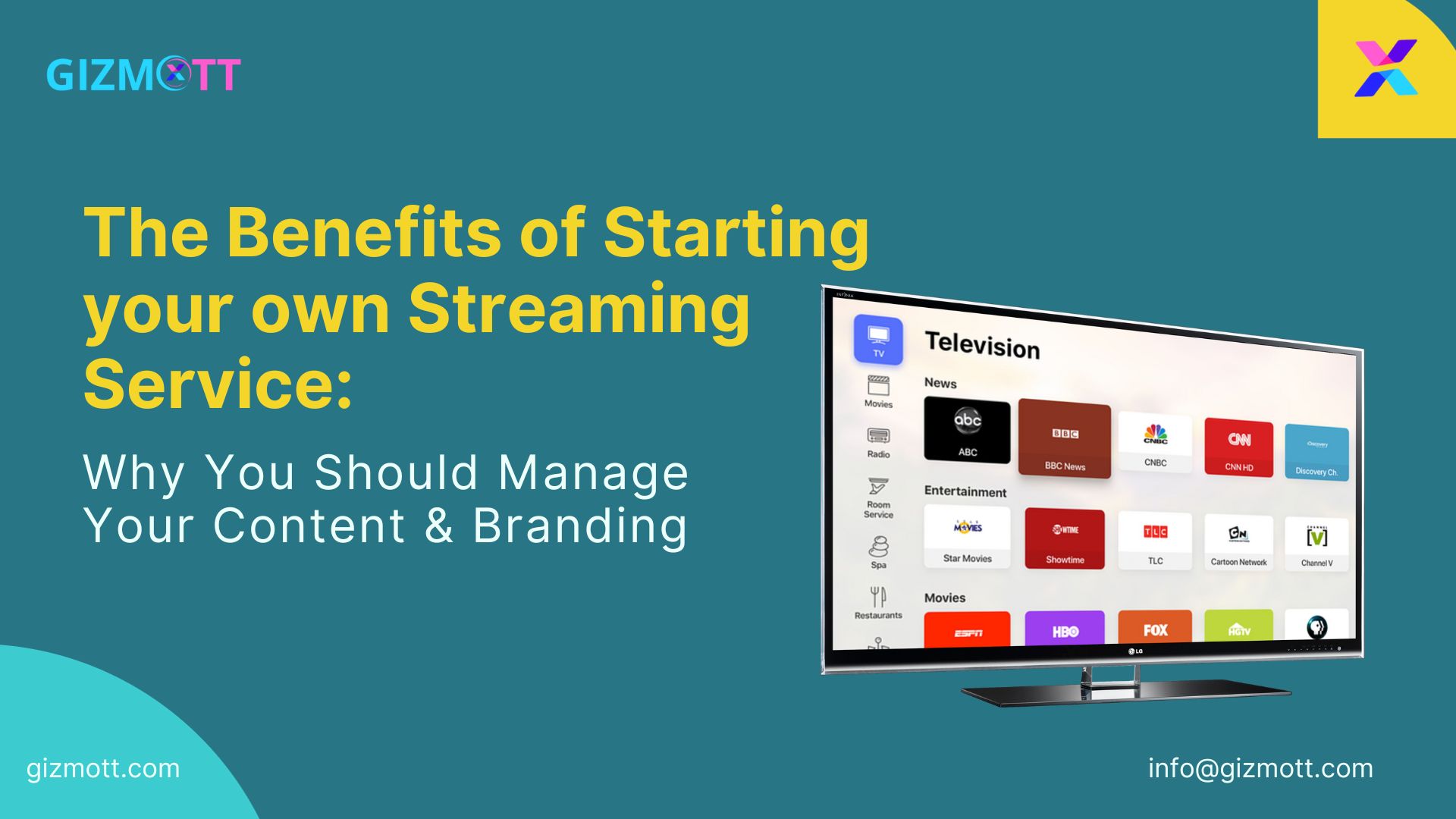Understanding IPTV: A Deep Dive into Modern Internet Protocol Television in 2025
The television landscape has transformed dramatically over the past decades. From black-and-white broadcasts to 4K and 8K streaming, TV has constantly evolved. In 2025, IPTV (Internet Protocol Television) stands at the forefront of modern television technology, redefining how audiences consume media.
Unlike traditional cable TV or satellite broadcasting, IPTV delivers content through the internet, offering on-demand viewing, interactive features, and multi-device access. This makes IPTV not just a replacement but a superior alternative to conventional TV systems.
The global IPTV market is expected to reach $194 billion by 2030, growing at a 17% CAGR. Platforms like Gizmott, powered by Gizmeon, are leading this revolution, enabling broadcasters, media companies, and content creators to launch feature-rich IPTV services.
High-volume keywords: IPTV streaming, Internet TV, OTT platform, IPTV service providers, IPTV technology.
What is IPTV? Internet Protocol Television Explained
IPTV (Internet Protocol Television) is a method of delivering television content over internet protocol (IP) networks, rather than traditional terrestrial, satellite, or cable formats.
Key benefits of IPTV over traditional TV:
-
Cable TV: One-way broadcasting, limited channels, fixed schedules.
-
IPTV Services: On-demand access, personalized recommendations, interactive experiences, multi-device streaming.
Gizmott simplifies IPTV delivery with a complete OTT and IPTV platform solution. Key features include:
-
Adaptive streaming for seamless content delivery.
-
AI-powered content recommendations for personalized user experience.
-
Multi-device compatibility, supporting smart TVs, mobile apps, web platforms, and set-top boxes.
-
DRM and anti-piracy protection, ensuring secure content distribution.
-
Monetization tools, including subscription management, ad integration, and hybrid models.
Keywords: IPTV definition, IPTV features, Internet TV, IPTV platform.
Evolution of Television: From Cable to IPTV Streaming
Television has witnessed significant technological advancements:
-
1950s: Black-and-white → Color TV.
-
1990s: Analog → Digital transmission.
-
2000s: Cable and satellite expansion.
-
2010s: Rise of OTT platforms.
-
2020s: IPTV streaming emerges as the leading television model.
Market Projections:
-
By 2025, IPTV subscribers will reach 150 million globally.
-
By 2027, IPTV users could exceed 200 million, while cable subscriptions continue to decline.
Gizmott is accelerating this transition by offering broadcasters and media companies a robust IPTV solution, combining live TV, VOD, AI personalization, and global monetization in a unified platform.
Keywords: IPTV growth, IPTV adoption, IPTV market forecast, OTT TV platform.
How IPTV Works: Step-by-Step Process
Understanding IPTV technology requires knowing how content flows from providers to viewers:
-
Content Sources: IPTV pulls content from live channels, sports events, VOD libraries, and OTT platforms.
-
Content Aggregation: Media is formatted into IPTV-compatible protocols for smooth transmission.
-
Transmission: Data is sent over secure internet networks.
-
Reception: Users access content via smart TVs, mobile apps, web platforms, or IPTV set-top boxes.
-
Decoding & Playback: Devices decode and play HD, 4K, or 8K streams without buffering.
Gizmott ensures the process is seamless by providing:
-
Cloud-based infrastructure for global scalability.
-
Adaptive bitrate streaming, maintaining quality even with variable internet speeds.
-
Comprehensive analytics, allowing providers to understand user behavior and engagement.
High-volume keywords: How IPTV works, IPTV streaming process, IPTV technology, OTT platform solution.
Advantages of IPTV in 2025
1. Flexibility and Personalization
-
Watch live or on-demand content anytime, anywhere.
-
Pause, rewind, or replay live streams.
-
AI-driven recommendations with Gizmott enhance user engagement and retention.
2. Cost-Effective IPTV Subscriptions
-
IPTV subscriptions are more affordable than cable TV.
-
Flexible pay-per-view, subscription, and hybrid monetization models.
-
Gizmott enables providers to launch tiered pricing strategies with ads or subscription options.
3. Multi-Device Streaming
-
Stream IPTV on smart TVs, mobile devices, tablets, web apps, and Firestick.
-
Gizmott’s cross-device compatibility ensures uninterrupted streaming for viewers.
4. High-Quality Streaming
-
Supports 4K Ultra HD, HDR, and immersive VR content.
-
5G IPTV will enable 8K streaming and low-latency live broadcasts by 2030.
-
Gizmott’s adaptive streaming guarantees optimal quality across all devices.
Keywords: IPTV advantages, benefits of IPTV, IPTV streaming quality, multi-device IPTV.
Best IPTV Devices in 2025
Top devices enhancing IPTV experiences include:
-
Amazon Fire TV Stick 4K – Affordable, Alexa-integrated.
-
Roku Streaming Stick+ – User-friendly, supports 4K HDR.
-
Apple TV 4K – Premium performance, excellent for Apple ecosystem.
-
MAG 522 IPTV Box – Specialized IPTV hardware.
Gizmott supports all major devices, making streaming easy and seamless across multiple platforms.
Keywords: Best IPTV devices, IPTV hardware, IPTV gadgets, IPTV streaming devices.
IPTV vs Cable TV: Why IPTV is Winning
| Feature | Cable TV | IPTV Services |
|---|---|---|
| Delivery | Cable/Satellite | Internet Protocol |
| Flexibility | Fixed schedules | On-demand, interactive |
| Cost | High subscription | Affordable IPTV plans |
| Devices | TV only | Multi-device streaming |
| Content | Regional | Global channels, OTT apps |
Industry Insight: By 2027, IPTV will surpass cable worldwide due to platforms like Gizmott, which provide AI personalization, global reach, and monetization tools.
Keywords: IPTV vs cable TV, IPTV superiority, IPTV adoption rate.
Challenges of IPTV Services
Despite its advantages, IPTV faces several hurdles:
-
High bandwidth requirements for HD/4K streaming.
-
Content piracy risks.
-
Regulatory differences across countries.
-
Cybersecurity threats.
Gizmott addresses these with:
-
DRM protection and anti-piracy tools.
-
Cloud scalability to handle traffic spikes.
-
Adaptive streaming for seamless playback.
-
Secure encryption protocols, protecting both content and user data.
Keywords: IPTV challenges, IPTV security, IPTV anti-piracy, IPTV streaming issues.
The Future of IPTV: 2025 and Beyond
The next decade of IPTV promises even more innovation:
-
5G IPTV Streaming: Ultra-low latency, zero buffering, live global events in real-time.
-
AI-Powered IPTV Platforms: Smarter content recommendations, predictive analytics for better user retention.
-
VR & AR IPTV Experiences: Immersive sports, concerts, and interactive events.
-
Blockchain IPTV Security: Transparent, piracy-proof content distribution.
Gizmott is already implementing these technologies, empowering broadcasters and media companies to stay ahead of the IPTV curve.
High-volume keywords: Future of IPTV, IPTV trends 2025, AI IPTV, 5G IPTV, OTT platform innovation.
IPTV Market Growth & Statistics (2025 Update)
-
Global IPTV market value (2024): $126 billion
-
Forecast by 2030: $194 billion
-
CAGR: 17%
-
Subscribers (2025): 150M → Expected 250M by 2030
-
By 2026, 55% of households in Europe and North America will adopt IPTV.
With Gizmott’s end-to-end IPTV and OTT platform solutions, content providers can capitalize on this booming market, expand globally, and maximize monetization opportunities.
Keywords: IPTV market growth, IPTV statistics 2025, IPTV subscribers forecast.
Why Gizmott is Powering the Future of IPTV
In 2025, IPTV is no longer a niche solution; it is becoming mainstream television technology. Gizmott – The Top OTT Platform Service Provider ensures content providers have all the tools to deliver premium IPTV services.
Key Gizmott Features:
-
AI-Powered Recommendations: Personalized content suggestions for viewers.
-
5G-Ready Streaming: Ultra-low latency, supporting HD, 4K, and upcoming 8K content.
-
Multi-Device Access: Smart TVs, mobile devices, tablets, and web apps.
-
DRM & Blockchain Security: Protect content from piracy and unauthorized access.
-
Flexible Monetization: Subscriptions, ad integration, and hybrid revenue models.
By integrating these features, Gizmott allows broadcasters, media companies, and content creators to stay ahead in the digital TV revolution, delivering premium, global IPTV experiences.



